 |
Convert MKV to JPG/JPEG Sequence
|
JPG/JPEG is a commonly used method of lossy compression
for digital photography (image). The degree of compression can be adjusted, allowing
a selectable tradeoff between storage size and image quality. JPEG typically achieves
10:1 compression with little perceptible loss in image quality.
MKV to JPG/JPEG Converter Software converts MKV to JPG/JPEG
sequence files. So, you could get every frame image of MKV in
JPG/JPEG format. You can also set output frame rate and JPG/JPEG resolution in
the software. The output JPG/JPEG files look something like the following screen
shot.
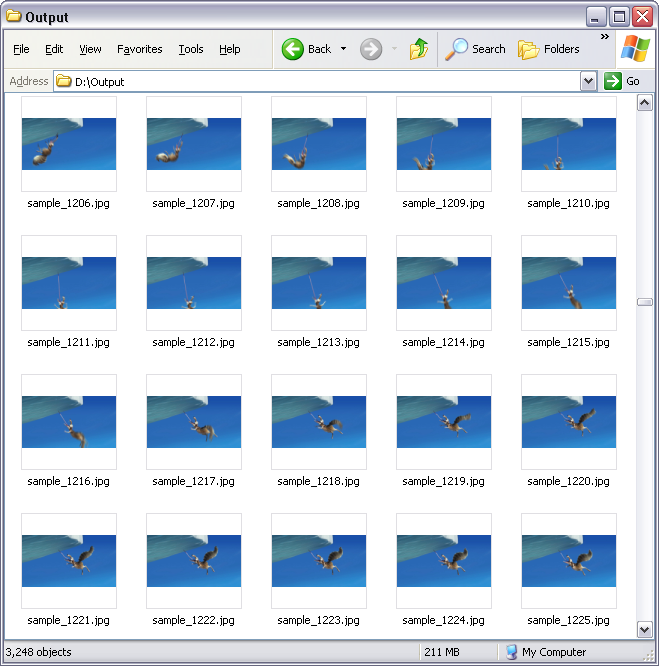
The software also supports other formats and portable devices such as MOV, WAV, AIFF, OGV, MPA, Android Tablet, AAC,
etc. The software could convert WebM to MP2, DIVX to M4B (MPEG-4 audiobook), EVO to PPM image sequence, WebM to ASF, WMV to FLAC, and so on.
MKV to JPG/JPEG Software supports batch conversion and, is compatible
with Windows 10/8/7/Vista/XP/2000.

What is MKV?
The Matroska Multimedia Container is an open standard, free container format,
a file format that can hold an unlimited number of video, audio, picture, or
subtitle tracks in one file. It is a universal format for storing common
multimedia content, like movies or TV shows. Matroska is similar in concept to other containers like AVI,
MP4, or Advanced Systems Format (ASF), but is entirely open in specification,
with implementations consisting mostly of open source software. Matroska
is similar in conception to other containers like AVI, MP4 or ASF, but
is completely open source. The name "matroska" was derived from
the Russian word "matryoshka," referring to the Russian dolls
that contain many dolls within one doll. All Matroska file types (to include
MKV) are open and free to use without license fee. Files are store in .MKV
file extensions. Hence, it often becomes necessary to convert MKV files
to MPEG1 VCDs or MPEG2 DVDs. Also, not all media players can play this
format, even with the codec pack installed. For a media player to read
MKV files, the latest codec pack must first be installed, usually recommended
from the Combined Community Codec Pack. Unlike most video formats, where
the SRT subtitle file exists independent of the video file, this file type
often contains a subtitle track that must be extracted if you want to use
the subtitles independently. It is intended to serve as a universal format
for storing common multimedia content, like movies or TV shows. Matroska
aims to become THE standard of multimedia container formats. A complete
CD or movie with subtitles can be stored within a single file. With this
capability, it can provide support for a variety of audio and video compression
formats.
What is JPG?
JPEG stands for Joint Photographic Experts Group. It is a standard method
of compressing photographic images. We also call JPEG the file format which
employs this compression. Although a JPEG file can be encoded in various
ways, most commonly it is done with JFIF encoding. If the data for a channel
does not represent an integer number of blocks then the encoder must fill
the remaining area of the incomplete blocks with some form of dummy data.
Filling the edges with a fixed color (for example, black) can create ringing
artifacts along the visible part of the border; repeating the edge pixels
is a common technique that reduces (but does not necessarily completely
eliminate) such artifacts, and more sophisticated border filling techniques
can also be applied. JPG compression is not lossless. JPG compression is
lossy. Lossy means "with losses" to image quality. JPEG 2000
is the latest series of standards from the JPEG committee. The original
standard for digital images (IS 10918-1, popularly referred to as JPEG)
was developed 15 years ago, and with the major increase in computer technology
since them, and lots of research, it was felt to be time for a new standard
capable of handling many more aspects than simply making the digital image
files as small as possible. Image files that employ JPEG compression are
commonly called "JPEG files", and are stored in variants of the
JIF image format. Most image capture devices (such as digital cameras)
that output JPEG are actually creating files in the Exif format, the format
that the camera industry has standardized on for metadata interchange.
On the other hand, since the Exif standard does not allow color profiles,
most image editing software stores JPEG in JFIF format, and also include
the APP1 segment from the Exif file to include the metadata in an almost-compliant
way; the JFIF standard is interpreted somewhat flexibly.
How to Convert MKV to JPG/JPEG Sequence?
- Free Download MKV to JPG/JPEG
Converter Software
- Install the Program by Step-by-step Instructions
- Launch MKV to JPG/JPEG Software
- Choose MKV Files

Click "Add Files" to choose MKV files.

Choose one or more MKV files you want to convert and then click Open.
MKV to JPG/JPEG Software will open MKV files and get file information
of the file such as width, height, frame rate, video bit rate, audio sample rate,
audio bit rate, audio channels, and then display the information of MKV file
at conversion list.
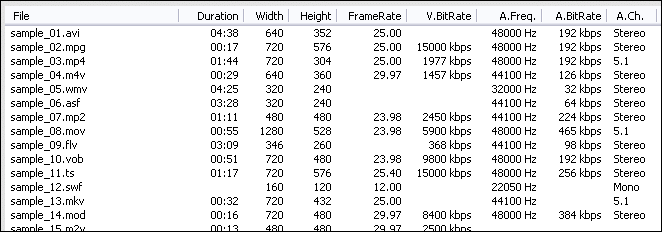
- Choose Output Format
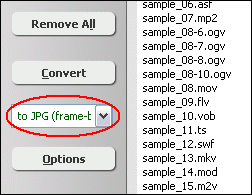
Click on combo-box of output format and then choose "to JPG (image sequence)".
- [Optional, for advanced user]
Set JPG Encoding Parameters
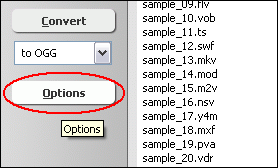
If you want to change JPG encoding parameters such as frame rate, video size,
aspect ratio, and so on, please click "Options".

And then, switch to tab "Video & Audio" and choose "JPG
(image sequence)" at "Output Format", and then set options
for image encoding.
- Convert MKV to JPG/JPEG
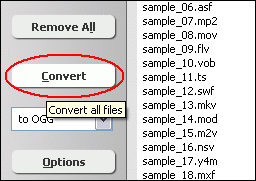
Click "Convert" to convert MKV to JPG/JPEG sequence.

The software is converting MKV files to JPG/JPEG.
- View and Browse JPG/JPEG Files
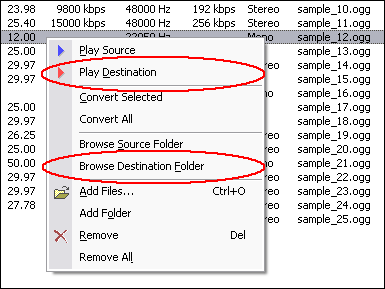
When conversion completes, you can right-click converted item and choose "Play
Destination" to view the first outputted JPG file; or choose "Browse
Destination Folder" to open Windows Explorer to browse the outputted JPG
files.
- Done
Top
MKV to JPG/JPEG Software is 100% clean and safe to
install. It's certified by major download sites.

Convert MKV to JPG/JPEG Related Topics:
|












